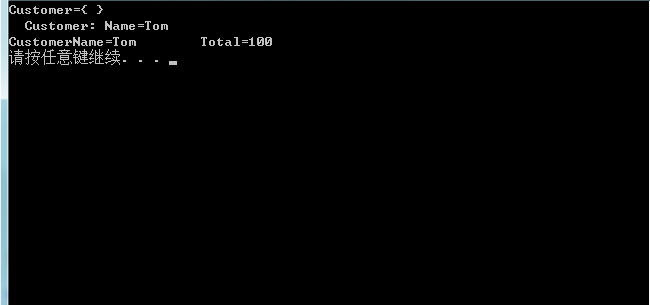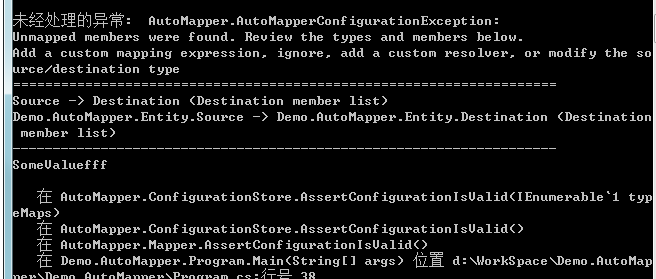.NET Core中使用AutoMapper
何为AutoMapper
AutoMapper是对象到对象的映射工具。在完成映射规则之后,AutoMapper可以将源对象转换为目标对象。
安装AutoMapper
这里我们在NuGet中下载安装AutoMapper。如下图

在项目中执行此命令

安装完成后 即可查看到依赖项中的 NuGet

配置AutoMapper映射规则
AutoMapper是基于约定的,因此在实用映射之前,我们需要先进行映射规则的配置。
public class ClubDetail
{
public int Id { get; set; } public string Name { get; set; } public string Creator { get; set; } public int Year { get; set; } public string Contact { get; set; } public string Phone { get; set; } public string Address { get; set; } public string Description { get; set; } public byte[] ImageData { get; set; } public string CreateNumber { get; set; }
} public class ClubDetailModel
{
public int Id { get; set; } public string Name { get; set; } public string Creator { get; set; } public int Year { get; set; } public string Contact { get; set; } public string Phone { get; set; } public string Address { get; set; } public string Description { get; set; } public string ImageDataBase64 { get; set; } public byte[] ImageData { get; set; } public IList<IFormFile> ImageUpload { get; set; } public string CreateNumber { get; set; } }
在上面的代码中,我们定义了两个类,我们需要将ClubDetil类的对象映射到ClubDetailModel类的对象上面。要完成这个操作,我们需要对AutoMapper进行如下配置:
CreateMap<ClubDetail, ClubDetailModel>();
用法:

这样,返回得到的就是映射后的ClubDetailModel了。
Profile的用法
Profile提供了一个命名的映射类,所有继承自Profile类的子类都是一个映射集合。
我们来看一下Profile的用法,这个例子中仍然使用上面的ClubDetil类和ClubDetailModel类。
public class ServiceProfiles : Profile
{
public ServiceProfiles()
{
CreateMap<ClubDetail, ClubDetailModel>().ReverseMap();//加ReverseMap是让两个实体可以相互映射
} }
然后 我们在Startup中ConfigureServices配置和初始化
Mapper.Initialize(cfg =>
{
cfg.AddProfile<ServiceProfiles>();
});
services.AddAutoMapper();
在一个Profile中,我们可以完成多个、更复杂的规则的约定:
public class Destination2
{
public int Id{ get; set; }
public string Name{ get; set; }
}
public class ServiceProfiles : Profile
{
public ServiceProfiles()
{
CreateMap<ClubDetail, ClubDetailModel>().ReverseMap(); CreateMap<ClubDetail, Destination2>().ForMember(d => d.AnotherValue2, opt =>
{
opt.MapFrom(s => s.AnotherValue);
});
}
}
AutoMapper最佳实践
这段内容将讨论AutoMapper的规则写在什么地方的问题。
在上一段中,我们已经知道了如何使用AutoMapper进行简单的对象映射,但是,在实际的项目中,我们会有很多类进行映射(从Entity转换为Dto,或者从Entity转换为ViewModel等),这么多的映射如何组织将成为一个问题。
首先我们需要定义一个Configuration.cs的类,该类提供AutoMapper规则配置的入口,它只提供一个静态的方法,在程序第一次运行的时候调用该方法完成配置。
当有多个Profile的时候,我们可以这样添加:
public class Configuration
{
public static void Configure()
{
Mapper.Initialize(cfg =>
{
cfg.AddProfile<Profiles.SourceProfile>();
cfg.AddProfile<Profiles.OrderProfile>();
cfg.AddProfile<Profiles.CalendarEventProfile>();
});
}
}
在程序运行的时候,只需要调用Configure方法即可。
了解了这些实现以后,我们可以再项目中添加AutoMapper文件夹,文件夹结构如下:

Configuration为我们的静态配置入口类;Profiles文件夹为我们所有Profile类的文件夹。
AutoMapper.Configuration.Configure();
扁平化映射(Flattening)
默认情况下,我们的ClubDetil类和ClubDetailModel类是根据属性名称进行匹配映射的。除此之外,默认的映射规则还有下面两种情况,我们称之为扁平化映射,即当Source类中不包含Destination类中的属性的时候,AutoMapper会将Destination类中的属性进行分割,或匹配“Get”开头的方法,例如:
Order类:
public class Order
{
public Customer Customer { get; set; } public decimal GetTotal()
{
return 100M;
}
}
Order类中包含了一个customer对象和一个GetTotal方法,为了方便演示,我直接将GetTotal方法返回100;
Customer类的定义如下:
public class Customer
{
public string Name { get; set; }
}
OrderDto类的定义如下:
public class OrderDto
{
public string CustomerName { get; set; }
public string Total { get; set; }
}
我们在进行映射的时候,不需要进行特殊的配置,既可以完成从Order到OrderDto的映射。
public class OrderProfile : Profile
{
protected override void Configure()
{
CreateMap<Entity.Order, Dto.OrderDto>();
}
}
测试代码:
Entity.Customer customer = new Entity.Customer() { Name = "Tom" };
Entity.Order order = new Entity.Order() { Customer = customer };
Dto.OrderDto orderDto = Mapper.Map<Dto.OrderDto>(order);
ObjectDumper.Write(order, );
ObjectDumper.Write(orderDto);
测试结果:

指定映射字段(Projection)
在实际的业务环境中,我们的ClubDetil类和ClubDetailModel类的字段不可能一对一的匹配,这个时候我们就需要来指定他们的实际映射关系,例如:
public class CalendarEvent
{
public DateTime Date { get; set; }
public string Title { get; set; }
} public class CalendarEventForm
{
public DateTime EventDate { get; set; }
public int EventHour { get; set; }
public int EventMinute { get; set; }
public string DisplayTitle { get; set; }
}
在这两个类中,CalendarEvent的Date将被拆分为CalendarEventForm的日期、时、分三个字段,Title也将对应DisplayTitle字段,那么相应的Profile定义如下:
public class CalendarEventProfile : Profile
{
protected override void Configure()
{
CreateMap<Entity.CalendarEvent, Entity.CalendarEventForm>()
.ForMember(dest => dest.EventDate, opt => opt.MapFrom(src => src.Date.Date))
.ForMember(dest => dest.EventHour, opt => opt.MapFrom(src => src.Date.Hour))
.ForMember(dest => dest.EventMinute, opt => opt.MapFrom(src => src.Date.Minute))
.ForMember(dest => dest.DisplayTitle, opt => opt.MapFrom(src => src.Title));
}
}
测试代码:
Entity.CalendarEvent calendarEvent = new Entity.CalendarEvent()
{
Date = DateTime.Now,
Title = "Demo Event"
};
Entity.CalendarEventForm calendarEventForm = Mapper.Map<Entity.CalendarEventForm>(calendarEvent);
ObjectDumper.Write(calendarEventForm);
测试结果:

验证配置项(Configuration Validation)
AutoMapper提供了一种验证机制,用来判断Destination类中的所有属性是否都被映射,如果存在未被映射的属性,则抛出异常。
验证的用法:
Mapper.AssertConfigurationIsValid();
例如:
public class Source
{
public int SomeValue { get; set; }
public string AnotherValue { get; set; }
}
Destination代码:
public class Destination
{
public int SomeValuefff { get; set; }
}
测试:
Mapper.CreateMap<Entity.Source, Entity.Destination>();
Mapper.AssertConfigurationIsValid();
运行程序将会出现AutoMapperConfigurationException异常:

这是因为SomeValuefff在Source类中没有对应的字段造成的。
解决这种异常的方法有:
指定映射字段,例如:
Mapper.CreateMap<Entity.Source, Entity.Destination>()
.ForMember(dest => dest.SomeValuefff, opt =>
{
opt.MapFrom(src => src.SomeValue);
});
或者使用Ignore方法:
Mapper.CreateMap<Entity.Source, Entity.Destination>()
.ForMember(dest => dest.SomeValuefff, opt =>
{
opt.Ignore();
});
或者使用自定义解析器,自定义解析器在下面讲到。
自定义解析器(Custom value resolvers)
AutoMapper允许我们自定义解析器来完成Source到Destination的值的转换。例如:
public class Source
{
public int Value1 { get; set; }
public int Value2 { get; set; }
} public class Destination
{
public int Total { get; set; }
}
Total属性在Source中不存在,如果现在创建映射规则,在映射的时候必然会抛出异常。这个时候我们就需要使用自定义解析器来完成映射。
自定义解析器需要实现 IValueResolver 接口,接口的定义如下:
public interface IValueResolver
{
ResolutionResult Resolve(ResolutionResult source);
}
我们来自定义一个Resolver:
public class CustomResolver : ValueResolver<Source, int>
{
protected override int ResolveCore(Source source)
{
return source.Value1 + source.Value2;
}
}
然后在映射规则中使用这个解析器:
public class SourceProfile : Profile
{
protected override void Configure()
{
//Source->Destination
CreateMap<Source, Destination>()
.ForMember(dest => dest.Total, opt =>
{
opt.ResolveUsing<CustomResolver>();
});
}
}
测试代码:
Source src = new Source()
{
Value1 = ,
Value2 =
};
Destination dest = Mapper.Map<Destination>(src);
ObjectDumper.Write(dest);
测试结果:

在使用自定义Resolver中,我们还可以指定Resolver的构造函数,例如:
//Source->Destination
CreateMap<Source, Destination>()
.ForMember(dest => dest.Total, opt =>
{
opt.ResolveUsing<CustomResolver>()
.ConstructedBy(() => new CustomResolver());
});
自定义类型转换器(Custom type converters)
AutoMapper通过ConvertUsing来使用自定义类型转换器。ConvertUsing有三种用法:
void ConvertUsing(Func<TSource, TDestination> mappingFunction);
void ConvertUsing(ITypeConverter<TSource, TDestination> converter);
void ConvertUsing<TTypeConverter>() where TTypeConverter : ITypeConverter<TSource, TDestination>;
当我们有如下的Source类和Destination类:
public class Source
{
public string Value1 { get; set; }
} public class Destination
{
public int Value1 { get; set; }
}
我们可以使用如下配置:
public class SourceProfile : Profile
{
protected override void Configure()
{
//string->int
CreateMap<string, int>()
.ConvertUsing(Convert.ToInt32);
//Source->Destination
CreateMap<Source, Destination>();
}
}
在上面的配置中,我们首先创建了从string到int的类型转换,这里使用了系统自带的Convert.ToInt32转换方法。
除了这种方法之外,我们还可以自定义类型转换器
public class CustomConverter : ITypeConverter<Source, Destination>
{
public Destination Convert(ResolutionContext context)
{
Source src = context.SourceValue as Source;
Destination dest = new Destination();
dest.Value1 = System.Convert.ToInt32(src.Value1); return dest;
}
}
通过这个转换器,我们可以绕过string到int的转换,直接将Source类的对象转换为Destination类的对象。
对应的配置如下:
public class SourceProfile : Profile
{
protected override void Configure()
{
//Source->Destination
CreateMap<Source, Destination>()
.ConvertUsing<CustomConverter>();
}
}
或者,我们也可以使用下面的配置:
public class SourceProfile : Profile
{
protected override void Configure()
{
//Source->Destination
CustomConverter converter = new CustomConverter();
CreateMap<Source, Destination>()
.ConvertUsing(converter);
}
}
空值替换(Null substitution)
空值替换允许我们将Source对象中的空值在转换为Destination的值的时候,使用指定的值来替换空值。
public class Source
{
public string Value { get; set; }
} public class Destination
{
public string Value { get; set; }
}
配置代码:
public class SourceProfile : Profile
{
protected override void Configure()
{
//Source->Destination
CreateMap<Source, Destination>()
.ForMember(dest => dest.Value, opt =>
{
opt.NullSubstitute("原始值为NULL");
});
}
}
测试代码:
Source src = new Source();
Destination dest = Mapper.Map<Destination>(src);
ObjectDumper.Write(dest);
测试结果:

条件映射(Conditional mapping)
条件映射只当Source类中的属性值满足一定条件的时候才进行映射。例如:
public class Foo
{
public int baz;
} public class Bar
{
public uint baz;
}
对应的配置代码如下:
Mapper.CreateMap<Foo, Bar>()
.ForMember(dest => dest.baz, opt =>
{
opt.Condition(src => (src.baz >= ));
});
总结
关于AutoMapper更多信息 还可移步官网 http://automapper.org/
.NET Core中使用AutoMapper的更多相关文章
- Dotnet Core中使用AutoMapper
官网:http://automapper.org/ 文档:https://automapper.readthedocs.io/en/latest/index.html GitHub:https://g ...
- ASP.NET CORE 中使用AutoMapper进行对象映射
ASP.NET CORE 中使用AutoMapper进行对象映射 1.什么是AutoMapper? AutoMapper是基于对象到对象约定的映射工具,常用于(但并不仅限制于)把复杂的对象模型转为DT ...
- ASP.NET.Core中使用AutoMapper
首先需要在NuGet中引用AutoMapper的类库 install-package AutoMapper install-package AutoMapper.Extensions.Micros ...
- ASP.NET Core Web 应用程序系列(五)- 在ASP.NET Core中使用AutoMapper进行实体映射
本章主要简单介绍下在ASP.NET Core中如何使用AutoMapper进行实体映射.在正式进入主题之前我们来看下几个概念: 1.数据库持久化对象PO(Persistent Object):顾名思义 ...
- .NET CORE 中使用AutoMapper进行对象映射
简介 AutoMapper uses a fluent configuration API to define an object-object mapping strategy. AutoMappe ...
- 在 ASP.NET Core 中使用 AutoMapper 使 Entity 和 Resource 之间进行映射
目录 从 NuGet 安装 AutoMapper 添加 Entity类 和 Resource类 添加一个 Profile文件,配置映射关系 在Startup中对AutoMapper进行注册 在项目中使 ...
- .Net Core 中使用AutoMapper
1.新建一个类 using AutoMapper; using YourModels; using YourViewModels; namespace YourNamespace { public c ...
- TransactionScope事务处理方法介绍及.NET Core中的注意事项 SQL Server数据库漏洞评估了解一下 预热ASP.NET MVC 的VIEW [AUTOMAPPER]反射自动注册AUTOMAPPER PROFILE
TransactionScope事务处理方法介绍及.NET Core中的注意事项 作者:依乐祝 原文链接:https://www.cnblogs.com/yilezhu/p/10170712.ht ...
- 在 ASP.NET Core 项目中使用 AutoMapper 进行实体映射
一.前言 在实际项目开发过程中,我们使用到的各种 ORM 组件都可以很便捷的将我们获取到的数据绑定到对应的 List<T> 集合中,因为我们最终想要在页面上展示的数据与数据库实体类之间可能 ...
随机推荐
- 表示一个文件的 File 类型
从本篇文章开始,我们将开启对 Java IO 系统的学习,本质上就是对文件的读写操作,听上去简单,其实并不容易.Java 的 IO 系统一直在完善和改进,设计了大量的类,也只有理解了这些类型被设计出来 ...
- lambda隐藏函数的嵌套
# 隐藏函数嵌套 f = (lambda a,b :a if a>b else b)(1000, 2000008) print((lambda a,g:a if a > g else g) ...
- 软件及博客的markdown支持度的评测
软件 vscode vscode原生支持markdown,但对数学公式的支持不太好,用 $$包含的数学公式不支持换行,而且在数学公式里面不能输入中文 Typora 非常简洁优美的软件,只有预览页,没有 ...
- 读《图解HTTP》有感-(返回结果的HTTP状态码)
写在前面 HTTP状态码是由服务端产生,用于告诉客户端,服务端处理结果的编码 正文 1.状态码的作用是什么?具有什么特征? 状态码的作用是当客户端向服务器发送请求时,描述服务器的响应结果(如:服务器正 ...
- UUID那些事
UUID那些事 UUID 是一个全局唯一的通用识别码.它使用某种规则,而不是某种中心化的自增方式,来保证这个识别码的全局唯一性.UUID 有非常多的使用场景,比如在分布式系统中,需要生成全局唯一 ID ...
- MQ、JMS 关系的理解
MQ简介: MQ全称为Message Queue, 消息队列(MQ)是一种应用程序对应用程序的通信方法.应用程序通过写和检索出入列队的针对应用程序的数据(消息)来通信,而无需专用连接来链接它们.消息传 ...
- U型理论
- jquery的$.extend和$.fn.extend作用及区别/用span实现进度条/腾讯云IIS端口号修改
jQuery为开发插件提拱了两个方法,分别是: jQuery.fn.extend(); jQuery.extend(); 虽然 javascript 没有明确的类的概念,但是用类来理解它,会更方便. ...
- JS(总结)
基础 Javascript是一种弱类型语言,它分别有什么优点和缺点 弱类型语言:简单好用,更灵活多变.但是会牺牲性能,比如一些隐含的类型转换 强类型语言:类型转换的时候非常严格,,强类型语言是直接操纵 ...
- 常见js特效的思路
1.焦点轮播路 1.布局:父容器用overflow:hidden隐藏多余的图片 2:通过ID获取到重要的元素(父容器.图片列表.左右切换按钮等) 给左右按钮加上点击事件,通过JS更新图片的位置,判断边 ...
